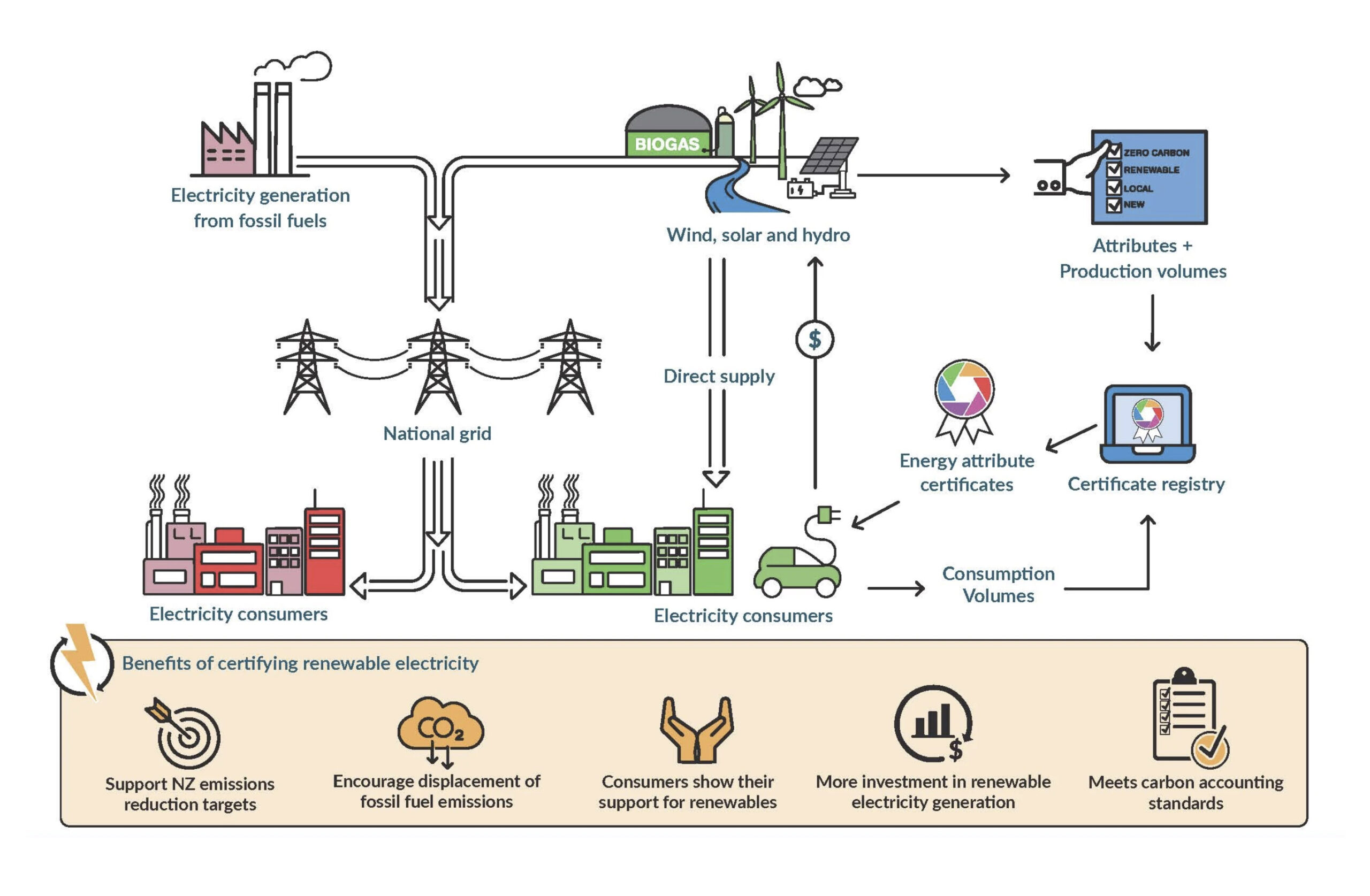You engage with a renewable energy retailer or supplier to buy energy in a way that meets your goals.
You, the supplier, and the underlying generation are registered, and the purchase is tracked on the NZECS.
The attributes of this energy are removed from the market, so that no one else can claim it, and no double-counting occurs.
The New Zealand Energy Certificate System (NZECS) is the registry platform that BraveTrace has developed and continues to operate. The NZECS enables consumers to claim ownership of energy production attributes from specific generation facilities. The system does not change the electrons that are supplied to you via the national grid.
Key aspects of operation
1 / National grid
All electricity (renewable or otherwise) is fed into the national grid. Via the thousands of kilometres of transmission and distribution lines, this electricity is supplied to the nation’s electricity consumers.
2 / Traceability
Once electricity enters the national grid, all the electrons mix. Without BraveTrace, this means that no consumer can know for certain where the electricity they use has come from.
3 / Certificate
BraveTrace enables generators of electricity to issue a ‘certificate’ for every unit of power they produce. This certificate shows how and when the energy was generated, and from where. This information is referred to as a ‘generation attribute’.
4 / Transfer
BraveTrace certificates can be traded and transferred from electricity generators to electricity retailers or brokers, who can ultimately sell these certificates to energy consumers. Through the purchase of a certificate, a consumer owns the renewable attributes of that unit of generation.
5 / Consumer choice
By purchasing generation certificates from renewable energy facilities, and matching them to their consumption via a process called ‘redemption’, a consumer can make clear statements about the type of electricity that they support.

6 / Reliable process
By tracking all of these statements, we can make sure that each unit of energy is only counted once, and that no one is making false claims.
7 / Transparency
Finally, by tracking the flow of certificates, we can accurately calculate the characteristics of the remaining supply to ensure that everyone gets a clear picture of the nature of the energy that they are purchasing.
As more and more consumers purchase certified energy, the ‘residual supply’ becomes less and less renewable, encouraging further behavioural change.
The New Zealand Energy Certificate System (NZECS)

FAQs
Energy certificates are used around the world to trace ownership of energy generation attributes. Recently introduced in New Zealand, some concepts can be unfamiliar. Some common questions are answered below.
BraveTrace aims to promote the production of renewable and zero carbon energy, as part of helping New Zealand reach its zero-carbon goals. As different sectors of the economy switch from carbon-based fuels, demand for electricity will increase. Energy certificates are part of the overall solution, which also includes energy efficiency and conservation, and other capital investments which reduce the amount of greenhouse gases emitted.
The BraveTrace System was established to support renewable generation. It will do so by reducing ‘double-counting’ of positive generation use, increasing awareness of how electricity is generated in NZ, and returning additional proceeds to operators and developers of renewable generation.
As well as offering certificates from existing renewable generation such as hydro dams and wind generation, BraveTrace works with small-scale projects including solar farms and community projects. Revenue from certificates gives them the ability to reinvest in further development and scale up faster.
There are multiple benefits from energy certificates: Awareness, understanding, avoiding double-counting, as well as the financial benefits and the potential to increase new generation.
We are in a time of unprecedentedly high awareness of emissions and demand for reduction in New Zealand. This environment makes it more likely that organisations will support building new generation through the NZECS and create a positive impact. Voluntary certificate schemes may not have the same impact internationally as mandated equivalents such as Renewable Portfolio Standards (RPS), but we believe that the NZECS will contribute to positive change and a voluntary scheme is the right way to start the ball rolling in New Zealand.
There are a number of articles that support both voluntary and mandatory schemes as having positive impact:
- ‘An electricity tracking and certification framework,such as the renewable energy certificate (REC), can be a powerful policy instrument to promote the acquisition of low-carbon electricity by the Scope 2 users.’ (2018)
- ‘REC trade can reduce the government’s expenditure on subsidies for renewable energy’ (2017)
- ‘Green certificates prices react to market changes, reducing regulatory costs.’ (2017)
- ‘Solar Renewable Energy Certificates (SREC) in the United States (U.S.) have become an important driver for promoting the solar photovoltaic (PV) system‘ (2017)
- ‘A certificate market … permits to obtain the desired level of renewable energy market share with good cost-efficiency (2013)‘
- ‘it is shown that the governmental grants and carbon credits are secondary support mechanisms compared to FiT and RECs‘ (2010)
We see an important benefit of the NZECS is improving consumer understanding of the relationship between electricity and emissions. Poor understanding is a recognised problem globally, as is double-counting. Organisations that assume the grid supply is carbon-free may report their Scope 2 emissions factor as zero. These are the sorts of misunderstandings we are keen to help correct.
The NZECS is the trading system for certificates and provides an open platform to all participants in the energy market to engage in attribute transfer via these certificates.
The system is run by BraveTrace, a commercial, for-purpose entity. Its core purpose is to support social and environmental benefits, by encouraging increased renewable and zero-carbon generation, and particularly projects that have co-benefits such as increasing local employment or reducing energy poverty.
In countries where governments have particular policy goals it is common for certificate use to be mandated by legislation. This is the case in Australia, Sweden, the US and EU member states. While this is common, it is equally possible for a market to determine the value of certification for themselves.
Once a need is established, energy certificate markets are often serviced by commercial businesses. There are a number of commercially-run registry providers internationally. A good example of this is Grexel, the largest provider of registry services internationally.
Companies that sell certificates are free to use the revenue from them as they wish. No certificate systems in the world mandate a specific use for sale proceeds. However, ideally companies will re-invest the proceeds from certificate sales into building further renewable energy generation or other decarbonisation efforts, or other projects with social or environmental benefits. In many cases, the sale of certificates will have been factored into calculations on a project ROI, helping the project get established in the first place.
In order to reach New Zealand’s zero-carbon goals, everyone in the energy sector has a part to play. As more users switch from carbon-based fuel to using electricity, demand for electricity will go up. Energy efficiency and conservation initiatives have a really important part to play in making sure that demand does not go up unnecessarily, and we all have a role to play in supporting the growth of renewable electricity generation.
Prices are negotiated between buyers and sellers, so are commercial in confidence. Different certificates have different prices depending on the type of generation and what additional properties people value – eg whether they want to support new build generation or community benefits. We already have project developers indicating to potential buyers the price they would need for the certificates to enable new-build projects to get off the ground, and we have seen interest from a number of organisations in purchasing these.
As the system grows, BraveTrace will develop and evolve the NZECS in line with the needs of the country. We have already asked for feedback from experts as the scheme was being established and have incorporated improvements as needed. We will evaluate potential system / rules changes, consult on these changes with the market and key industry stakeholders, and implement the appropriate ones. Some things we plan to closely investigate are baseline years (or certificate classes), granular reconciliation, and supplier portfolio certification.
The certificates are in megawatt-hours. For every megawatt-hour of renewable electricity produced during a year, the generators can sell one megawatt-hours-worth of renewable attributes, in the form of a certificate.
BraveTrace is the company that operates the NZECS. Some participants may be more familiar with the name NZECS as that is what they interact with for the certificates.
